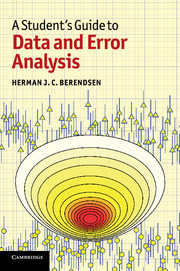Book contents
- Frontmatter
- Contents
- Preface
- Part I Data and error analysis
- 1 Introduction
- 2 The presentation of physical quantities with their inaccuracies
- 3 Errors: classification and propagation
- 4 Probability distributions
- 5 Processing of experimental data
- 6 Graphical handling of data with errors
- 7 Fitting functions to data
- 8 Back to Bayes: knowledge as a probability distribution
- References
- Answers to exercises
- Part II Appendices
- Part III Python codes
- Part IV Scientific data
- Index
6 - Graphical handling of data with errors
Published online by Cambridge University Press: 05 June 2012
- Frontmatter
- Contents
- Preface
- Part I Data and error analysis
- 1 Introduction
- 2 The presentation of physical quantities with their inaccuracies
- 3 Errors: classification and propagation
- 4 Probability distributions
- 5 Processing of experimental data
- 6 Graphical handling of data with errors
- 7 Fitting functions to data
- 8 Back to Bayes: knowledge as a probability distribution
- References
- Answers to exercises
- Part II Appendices
- Part III Python codes
- Part IV Scientific data
- Index
Summary
Often you perform a series of experiments in which you vary an independent variable, such as temperature. What you are really interested in is the relation between the measured values and the independent variables, but the trouble is that your experimental values contain statistical deviations. You may already have a theory about the form of this relation and use the experiment to derive the still unknown parameters. It can also happen that the experiment is used to validate the theory or to decide on a modification. In this chapter a global view is taken and functional relations are qualitatively evaluated using simple graphical presentations of the experimental data. The trick of transforming functional relations to a linear form allows quick graphical interpretations. Even the inaccuracies of the parameters can be graphically estimated. If you want accurate results, then skip to the next chapter.
Introduction
In the previous chapter you have learned how to handle a series of equivalent measurements that should have produced equal results if there had been no random deviations in the measured data. Very commonly, however, a quantity yi is measured as a function f(xi) of an independent variable xi such as time, temperature, distance, concentration or bin number. The measured quantity may also be a function of several such variables. Usually the independent variables – which are under the control of the experimenter – are known with high accuracy and the dependent variables – the measured values – are subject to random errors.
- Type
- Chapter
- Information
- A Student's Guide to Data and Error Analysis , pp. 71 - 83Publisher: Cambridge University PressPrint publication year: 2011

